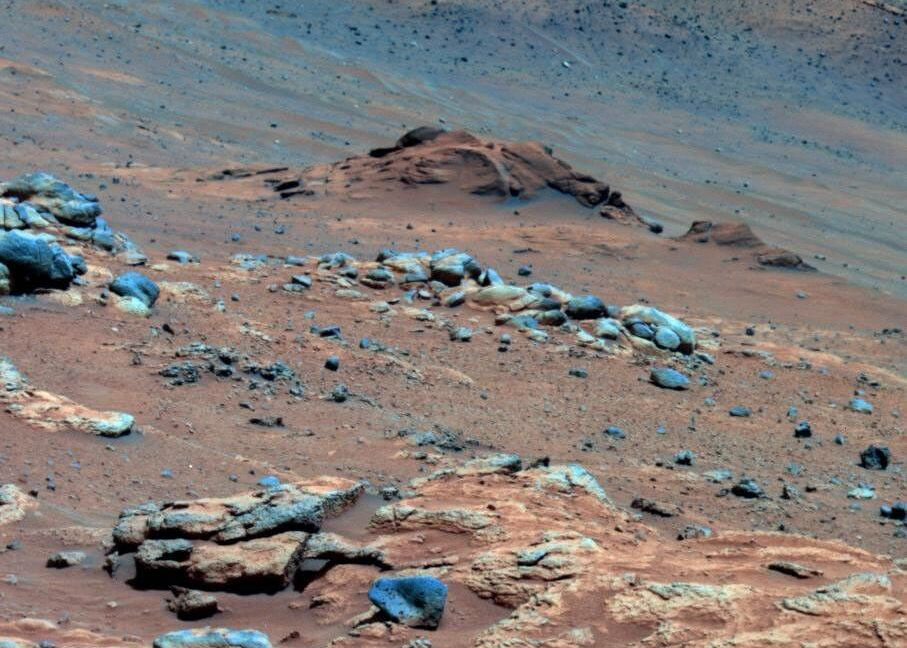Science
New Martian Climate Model Reveals Harsh Environment for Life

A recent climate model developed by a team of scientists from the University of Chicago suggests that Mars has been predominantly cold and inhospitable, raising questions about the potential for life on the planet. The model, which incorporates findings from the Curiosity rover’s exploration of Mount Sharp, indicates that a significant portion of carbon dioxide in the Martian atmosphere may have been trapped in sedimentary rocks, similar to limestone formations on Earth. This process could have diminished the greenhouse effect that previously warmed the Martian surface.
Led by Edwin Kite, a professor of planetary science at the University of Chicago and a member of the Curiosity science team, the research builds upon earlier work by Benjamin Tutolo, a researcher at the University of Calgary. The model examines the evolution of Martian conditions over a span of 3.5 billion years, integrating data on Martian topography, solar luminosity, and orbital dynamics.
“This has been under development for the last couple of years, along with the paper on the carbonate rocks,” Tutolo noted, emphasizing the importance of the Curiosity rover’s findings. Previous models lacked the spatial resolution necessary to accurately simulate long-term climatic changes. Kite’s team claims to have created the first spatially resolved, long-term climate evolution model for Mars.
The model suggests that early in Mars’ history, approximately 4 billion years ago, the planet was warm enough to support lakes and river networks. According to Kite, “There were seas, and some of those seas were as big as the Caspian Sea, maybe bigger. It was a wet place.” However, this period of wetness was brief, preventing extensive weathering and erosion of the landscape.
As temperatures declined, the era of salts began, leading to the formation of expansive salt flats. Kite explained, “Big areas of snowmelts created huge salt flats, which eventually built up over time.” Despite the transition to a colder climate, the model indicates that liquid water occasionally resurfaced in small oases.
The research paints a challenging picture of Martian habitability. “There were long periods when the planet was entirely dry,” Kite stated. During these dry phases, Mars experienced extreme cold. Nevertheless, transient lakes would form, offering brief moments of potential habitability fueled by melted snow.
Kite emphasized the difficulty in determining whether life could have originated on ancient Mars. He raised a thought experiment: “You can do a thought experiment where you take a cup of water from the Earth’s ocean and pour it into one of those transient lakes on Mars.” While some microbes might survive, the greater question remains whether life could have developed on the planet in the first place.
Given the long durations of dry periods and the brief existence of oases—approximately 100,000 years—Kite concluded that conditions were likely too harsh for surface life to thrive. Consequently, all the oases in this model were deemed uninhabited.
While the model provides valuable insights, Kite acknowledged limitations in its findings. Most data comes from a single location, Mount Sharp, raising concerns about the model’s representativeness of the entire Martian surface. “The biggest limitation of this model is that most of the data it’s based on comes from one place and one rover,” Kite noted. Future discoveries by Curiosity could further refine or challenge this model, particularly regarding carbonate deposition.
The model also does not account for conditions prior to the salt era, during which Mars likely had more surface water and a warmer climate. Kite expressed the need for a non-carbon dioxide warming agent to explain this earlier warmth.
In conclusion, while the research suggests a bleak outlook for Martian life, Kite remains cautiously optimistic. He proposes that subsurface waters might have provided refuge for potential microbes during dry periods, allowing them to surface during brief habitable moments. “I think we can’t completely close the door on Martian life just yet,” he stated, urging further exploration for biologically produced molecules in ancient Martian rocks.
The findings were published in Nature on March 15, 2025, and could significantly impact our understanding of Mars’ climatic history and the potential for life on the planet.
-

 Politics4 weeks ago
Politics4 weeks agoSecwepemc First Nation Seeks Aboriginal Title Over Kamloops Area
-

 World5 months ago
World5 months agoScientists Unearth Ancient Antarctic Ice to Unlock Climate Secrets
-

 Entertainment5 months ago
Entertainment5 months agoTrump and McCormick to Announce $70 Billion Energy Investments
-

 Science5 months ago
Science5 months agoFour Astronauts Return to Earth After International Space Station Mission
-

 Lifestyle5 months ago
Lifestyle5 months agoTransLink Launches Food Truck Program to Boost Revenue in Vancouver
-

 Technology3 months ago
Technology3 months agoApple Notes Enhances Functionality with Markdown Support in macOS 26
-

 Lifestyle3 months ago
Lifestyle3 months agoManitoba’s Burger Champion Shines Again Amid Dining Innovations
-

 Top Stories2 months ago
Top Stories2 months agoUrgent Update: Fatal Crash on Highway 99 Claims Life of Pitt Meadows Man
-

 Politics4 months ago
Politics4 months agoUkrainian Tennis Star Elina Svitolina Faces Death Threats Online
-

 Sports5 months ago
Sports5 months agoSearch Underway for Missing Hunter Amid Hokkaido Bear Emergency
-

 Politics5 months ago
Politics5 months agoCarney Engages First Nations Leaders at Development Law Summit
-

 Technology5 months ago
Technology5 months agoFrosthaven Launches Early Access on July 31, 2025





















